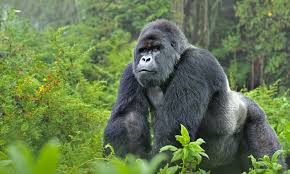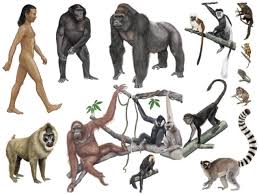The order primates contain over 700 species of animals. Although there is variation in there sizes, colour, shapes, intelligence and habits, there are features common to all primates. This order includes the families Losrisidae (Pottos and Angwantibo); Galagidae (Galagos);
Cercopithecidae (Tantalus, Patas, Colobus monkeys, Drill and Baboon); and Pongidae (Gorilla and Chimpanzee).
The members of the order proboscidea are the elephants. Elephants are probably the best known of all African mammals. Their vast size and bulk (reaching 11ft and 7 tonnes) seem almost improbable and a large herd of elephant is a magnificent sight not easily forgotten.
There are two living species; the African elephant (Loxodonta africana) and the Indian elephant (Elephas maximus) are the only survivors of an order that was extremely
successful from about 26 million to 1 million years ago.
The primates are probably the most highly developed order of mammals. They have relatively large complex brains, binocular vision, nails instead of claws on most digits, an opposable first digit enabling them to grasp objects with the hand or the foot. Primates are adaptable intelligent mammals. Most species live in stable cohesive social groups.
They have a variety of vocal sounds, expressions and actions/movements with which they communicate with other members of the same species. They are mainly arboreal species inhabiting the rainforests. There are four families, and these are:
1. Lorisidae
2. Galagidae prosimians).
3. Cercopithecidae (true monkeys) and
4. Pongidae (e.g Gorilla and Chimpanzee)
Characteristic Features of Common Primates
The characteristic features of the common members of the order primates are the following. Three well-known species described in the order Anubis baboon (Papio anubis), Chimpanzee (Pan troglodytes) and Gorilla (Gorilla gorilla).
1. Anubis Baboon (Papio anubis)
Identification: A large heavily-built monkey, with the back sloping downwards from shoulders to base of tail. Pelage coarse and dense, olive-brown, often speckled because of alternating dark and light bands of hairs.
Hair on neck, shoulders, and chest of adult males elongated to form a mane. Head large with small eyes, and dull black-skinned muzzle and lips. Ears small, usually hidden by the pelage. Fore- and hind-limbs more or less equal in length, hands and feet black.
Large hairless buttocks in adults; buttocks of females become very swollen and red during oestrus. Tail fairly long, sparsely covered with hair, often held horizontally and bending downwards at the tip. Males are significantly larger than females.
Anubis baboons are found in wooded savannahs and on rocky inselbergs. They feed on a wide variety of fruits, bulbs, roots, shoots, insects and small vertebrates. Despite their large size, baboons are able to climb trees quickly with age, and scramble up and down rocky slopes
with great agility. At night baboons rest on topmost branches of tress.
Baboons live in groups – troops. A troop, which may number as many as forty individuals or more, is composed of females and their young, adolescents of both sexes, and a number of adult males.
There is well developed social hierarchy amongst the troops of baboon which is based on dominance relationship between individuals. The young are born single and are carried by the mother close to her chest. Later the young may be carried on the back near the tail. Baboons produce a variety of sounds although most characteristic is a dog-like bark associated with alarm and danger.
2. Chimpanzee (Pantroglo dytes)
Identification: This description is in respect of forest chimpanzee, Pan troglodytes verus. A large robust ape. face pale, with dark mask around eyes and large pale ears. Small nostrils opening above a large forwardly projecting upper lip; nostrils closer to eyes than to mouth.
Top of head rounded without sagittal crest. Body and legs with sparse black hairs, turning grey on some parts of the body in old individuals. Hands hairless, with long fingers. Walks and runs with weight on sole of footand on middle phalanges of fingers. When standing upright, forelimbs do not reach level of knees. Buttocks hairless, pale, and especially of occipital and nuchal crests.
Chimpanzees are arboreal and terrestrial. They normally walk and run on all four limbs but can do same on the hind limbs for short distances. At night they make nest in trees using twigs and branches to form a simple platform. Each nest is normally used for only one night. Chimpanzees live in groups of 2-25 individuals. The groups may be of the following types:
• Adult male and female groups
• Male groups
• Female and young groups
• Mixed groups of all ages and sexes.
They have a wide variety of vocal sounds, postures, expressions and activities with which information is passed between individuals and groups. Chimpanzees are probably the most intelligent of all primates.
They feed on fruits and nuts and sometimes on leaves and insects. Sticks and twigs at times are used to procure food. They usually have one young after a gestation period of 236 days. Adult size and maturity is attained in 7 – 9 years.
3. Gorilla (Gorilla gorilla)

Identification: The Gorilla is the largest of all the primates. The female is considerably smaller than males. Head large and black, face hairless with prominent supraorbital ridge. Large round nostrils closer to mouth than to eyes. Ears small, mostly hidden by pelage. Crown of head
conical due to development of bony occipital crest on head, nuchal crest on neck, and their associated muscles. Body thickset and robust, chest deep and barrel-like, back sloping downwards towards pelvic region.
Forearms long, thickset and powerful; hands broad with short fingers. Hindlimbs thickset, shorter than forelimbs. Pelage typically black, short, dense, and soft; hairs longer on forearms, chest and shoulders, especially in males. Adult males may have white or silver hairs on back forming a ‘saddle’. Locomotion is similar to that of chimpanzee.
Gorillas live in lowland and montane rainforests. They are mostly terrestrial, although they also climb trees with caution. At night they sleep in nests, similar to those of chimpanzees, on the ground or in trees.
They are entirely herbivores, feeding on fruits, stems, leaves, and bark of trees. Gorilla groups ranging between 5 and 30 individuals are composed of one or more males, several females and sub-adult males, and young.
Solitary males are fairly common. Each group is led by a dominant male who never-the-less allows other males, to remain in the groups. There is a well-developed communication between members of the group through facial expressions, postures and vocalisation.
Read Also: Order of Carnivora and Perissodactyla: Species, Characteristics and their Economic Importance
However, gorillas are generally much quieter animals than the noisy chimpanzees. Sometimes males may stand bipedally and show an intimidation display of chest-beating and roaring. Gorillas have a gestation period of 255 days, and normally have a simple young at parturition. Sexual maturity is attained at about 8 years.
Order of Proboscidea
Elephant possess many unique and specialised characteristics. The nose and upper lip are elongated to form mobile and extremely sensitive trunk which is used for breathing, gathering food, squirting water, communication between individuals by touch, posture and for combat.
On either side of the trunk the third upper incisor tooth is elongated to form a tusk made entirely of enamel (but the female Indian elephant has no tusk). The size of the tusks varies greatly depending on sex, age, rate of growth and locality (Happold, 1987).
The tusks are extremely hard and are used to gather food, strip barks from trees, carry and support objects and for defense.
Inside the mouth, the large check teeth are modified to cope with the enormous quantity of food that have to be chewed. During its life an elephant has six check teeth on each side of upper and lower jaws.
However, only one pair of check teeth is used at a time and as each tooth wears down it moves forward in the jaw and is replaced by a new tooth from behind. Each canine tooth is about 30cm long and about 10cm wide and is composed of horizontal base of enamel and dentine, which forms a stronger grinding surface (Laws, 1996).
The large domed-head has small eyes and large ears, which can be flapped forward and backward. The skin is thick and wrinkled without sweat glands and with sparse coarse bristles. The limbs are necessarily thickset to support the weight of the body, and the feet are flat and almost circular in outline with four or five flattened nails.
The tail is short with a tuft of black bristles. Due to their large size and food requirement elephants play a significant role in the ecosystem. They are entirely herbivorous eating a wide range of grasses, leaves and fruits.
Elephants spend 12 to 16 hours foraging and eating each day. An adult elephant consumes 180-270kg of vegetation each day (Happold, 1987). Elephants break branches, rip bark from trees with their tusks and even knock down whole trees.
The sheer volume of food required and the destructive method by which they obtain food can result in considerable changes in the structure and species composition of the habitat when elephant becomes too numerous.
In several regions of Eastern Africa where elephant population are too large there has been widespread alteration of the environment making it unsuitable for the elephant as well as for many other species of birds and mammals.
Elephants need to consume large amount of food everyday due to their inefficient digestive system. They produce copious amount of dung each day that contain a lot of undigested stems, seeds and other vegetable materials.
Elephants swallow their food without much chewing and most of the breakdown is by fermentation in the gut. This process results in the production of lots of gasses and is thought to be responsible for the ‘rumbling sounds’, which can quite often be heard when elephants are nearby.
The dung act as an excellent environment for germination of seeds, which pass unharmed through the elephant’s digestive system. In this way the seeds are dispersed away from the parent plant and given rich moist ‘compost’ for germination (Happold, 1987).
Elephant usually live in groups or herds. Herd size varies depending on population density, location and season. Herds are composed either of females, immatures and juveniles or only males. Herds split and join so that very large herds are usually temporary aggregation of smaller herds.
Herds also break up into smaller ones during food scarcity. At puberty males leave the mother and young herds to join the bachelor herd of males. Males join the female herd for mating (Happold, 1987).
An elephant delivers a single offspring after a period of 22 months (approximately two years). The offspring (calf) suckles for about 2 years and matures at 14-20 years depending on the environment.
Elephants continue to grow even after sexual maturity; females (cows) reach adult size at 20 – 25 years but bulls (males) continue to grow and increase in weight until 30 – 35 years (laws and Parker 1968). Female elephants can produce one calf in every 4 years, although more typically the time interval between calves is 6 – 10 year.
The slow rate of breeding and growth in elephants means that many years are required to increase population numbers (Happold, 1987). The only species in Nigeria for instance is the
African elephant, Loxodonta africana. Then there are the forest sub-species, L. african cyclotis and the savanna sub-species, L. africana oxyotis. The distinctive characteristics of the two sub-species are as shown in the following table.
Features L African cyclotis L. African oxyotis.
1. Tusks Thinner, lighter and Thicker, heavier and generally comparatively straighter curving forward (point downward)
2. Trunk Dense covering of Sparse bristles and Head bristles on head and upper part of trunk
3 Ears Comparatively small and rounded at base (about 90cm from top up to base). Comparatively large and pointed at base (about 150cm from top to base).
4. Size Smaller in size and Larger in size and weights weight.
Read Also: Order of Artiodactyla: Species, Characteristics and their Economic Importance

